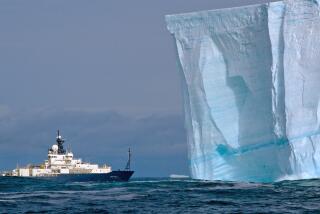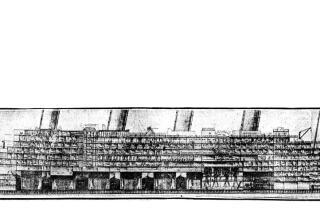The Elite Enjoy Atlantic Crossings on the QE2 : Travel: A special breed of oceangoing voyagers are distinguishable from passengers on cruise ships. They love the old traditions, and many make the trip again and again.
ABOARD THE QUEEN ELIZABETH 2 — Wrapped in a cocoon of steamer rugs in a pitching deck chair or striding the decks at a 25-degree angle in a gale, the transatlantic passenger is far from an endangered species.
Unless, of course, you consider the danger of overeating at the midnight buffet or of a severe scalding from that midmorning mug of bouillon or perhaps hyperventilating when the stakes are high and the wooden nags run neck-and-neck at the horse races in the lounge.
The transatlantic passenger--the one in the sensible shoes, waterproof ulster with tweed scarf and a checkered cubbing cap--endures and even makes a profit for the ship owners because they must go down to the sea again--and again and again.
“One-third are repeats,” said Capt. Robin Woodall of the Queen Elizabeth 2. “There’s a lady with us on this voyage who has made 106 crossings.”
Crossings are the way the ocean-struck refer to transiting the North Atlantic in either direction. The woman who had logged 106 crossings had actually made 53 round trips, which still beats many crew members, including John Duffy, the QE2’s hotel manager, who has been at sea for nearly half of his 44 years.
“Transatlantic passengers are a different breed from those who cruise the Caribbean and the Mediterranean with us. They love the old traditions,” says Duffy, who numbers himself among the traditionalists. “They don’t jog, but they’re out having a brisk morning promenade around the deck at an hour when your cruise types are leaving the disco and heading to bed. Then they sit down to the traditional breakfast of kippers, porridge, marmalade on toast.”
“Ancient mariners,” as frequent commuters across the pond are known in the travel trade, invariably book the same cabin with the same stewards and ask to be seated at the same table and served by waiters they have known for years.
“There are a lot of people on this particular voyage whom I would call crossing people rather than cruise people. You can spot them by the way they know and use the ship,” says Keith Gledhill, who runs a hot-water heater firm in Blackpool, England. “On cruises, you’re getting into launches and going ashore to various ports. But transatlantic, you are more a part of the ship, enjoying the entertainment, sitting down to bridge in the card room, dressing for dinner. If you look in on the captain’s reception the second night out, there is still that elegance: beautiful dresses, smart tuxedos, like a snapshot taken 40 years ago. Whereas cruise people are in a holiday mood and tend to dress more casually.”
Ensconced in a penthouse suite on the signal deck just aft of the bridge, Gledhill well remembers the pre-jet era when liners were the only way to go. From 1949 to 1954, he was a junior purser “on the old Queens, the Mary and the Elizabeth.” He logged 120 crossings, including one with Winston Churchill aboard and another “when the liner United States sped past us, doing 35.5 knots, to capture the Blue Riband,” the trophy for the speediest Atlantic crossing.
With his wife, Gledhill has made some 30 more crossings as a passenger, often turning around as fast as the ship. “Our idea of a vacation is get on in Southampton, straight across to New York for a quick lunch at the Oyster Bar in Grand Central with friends we met on the Queen Mary in 1965, then back to Southampton.”
The QE2 will make 27 crossings in the 1992 season, beginning in April, just after her world cruise, and ending in late December. In summer she runs full: 1,900 passengers, and seldom drops below 1,400 in months when the weather is less promising. Many cruise lines such as Royal Viking, Holland America, Sun Lines and P&O; do well carrying passengers when repositioning their ships between the Mediterranean in summer and the Caribbean in winter. Cabins on Lykes Bros. freighters, serving Livorno, Italy, are booked six to nine months in advance and, even with a civil war raging, Yugoslav freighters are fully booked.
Capt. Woodall, who entered Cunard’s passenger service shortly after that fateful October morning in 1956 when the first passenger jet lifted off from New York’s Idyllwild Airport, has an unquenchable faith in the survivability of the transatlantic ship passenger. Besides “those fear of flying chaps,” he identifies three different species of that durable breed:
“There is the businessman or businesswoman who may well fly in one direction but comes aboard either to prepare for an important meeting or is using the ship to unwind afterward. You see lots of attache cases in the library and public rooms.
“Next are families relocating. They have an automobile on board, lots of luggage in the hold. They prefer having their possessions with them, rather than flying and having them shipped.
“Then there is the tourist going over to Europe or the United States, who regards shipboard life as part of the total experience.”
With auto rental costs rising throughout Europe “having your car on board is convenient and more economical,” says Frederick Pillsbury of Key West, Fla., whose 1990 Range Rover was in the hold, ready to roll when his luggage cleared customs.
In a reprise of the ‘20s, celebrities again are going up the gangplank. Recent passengers included Julie Andrews, Andrew Lloyd Weber, Caspar Weinberger, Telly Savalas, Michael Crawford, Cleveland Amory and Dean Martin. Terence Stamp and Douglas Fairbanks Jr. are deemed “regulars” by the crew.
“Transatlantic passengers are marginally younger than those on cruises,” in the opinion of June Appleby, librarian of the QE2’s 6,000-volume library. “They’re more hyper when they come aboard, more intense about where they are going. They do a lot of research into routes and destinations. About 1,000 books go out on a crossing, mostly biographies, histories, anything about the royal family. Cruise passengers take out fewer books, mostly bestsellers and romantic novels. During evening hours on a crossing, there is a rush for reference works to settle arguments that came up at dinner.”
Captains work harder on an Atlantic crossing. Fog off the Grand Banks and the world’s most unpredictable sea and weather conditions require long hours on the bridge. “A North Atlantic storm can be more ferocious than a hurricane and come up with less warning,” says Woodall over the melancholy moan of the foghorn, on automatic, every two minutes, off Newfoundland’s Cape Race. Near here two decades ago, the QE2 battled the worst storm in his experience. “Waves 100 feet high put us two days late into Southampton.”
Social life on the Atlantic also makes greater demands. “You’re concentrating a lot into 4 1/2 days,” the captain sighs. “Three formal nights in a row and all those receptions.”
Crossing people tend to spend less time in the casino, the physical fitness rooms, the “computer learning center” and similar innovations borrowed from the cruise ships. They are more apt to be at shuffleboard when the noon whistle bellows or tossing deck quoits as, directly overhead, the Concorde emits its double sonic boom on a flight path subtly coordinated with the ship. They get as excited as Columbus’ crew at sighting the first sea gull and shiver at the rail by dawn’s early light to catch Bishop’s Rock Light, England’s earliest landfall, blinking over the horizon.
The fate of the Titanic is their constant fascination. The entire crew is pestered with queries as to when the ship will approach latitude 41.46 north, longitude 50.14 west, where that murderous iceberg lurked on an April night in 1912.
“We’ll be right over her in a tick,” deck stewards invariably oblige.
From his table adjoining ours, Charles Ira Sachs issued invitations to a “Titanic and Cocktails Party.” A noted Los Angeles collector of Atlantic liner memorabilia, Sachs showed a video of the recent expedition he joined to probe the sunken wreck, using expert divers and rented Russian ships.
Hotel Manager Duffy recently had at his table the great-granddaughter of Thomas Andrews, director of the shipyard that built the Titanic, and on another occasion a descendant of J. Bruce Ismay, the White Star Line chairman who was hounded into a life of seclusion for getting into a lifeboat and not going down with his ship.
Talk of icebergs at the captain’s reception always cues in Woodall for the last gruff word on the subject: “The only ice I feel comfortable with on the North Atlantic is in my glass.”
More to Read
Sign up for The Wild
We’ll help you find the best places to hike, bike and run, as well as the perfect silent spots for meditation and yoga.
You may occasionally receive promotional content from the Los Angeles Times.






